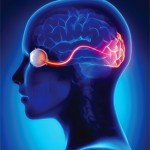
In this case of a neuromyelitis optica spectrum disorder, the patient presented with bilateral vision loss.
Lightspring/shutterstock.com
Case Presentation
The patient was a 42-year-old African American female diagnosed with systemic lupus erythematosus (SLE) based on the findings of polyarthritis, malar and discoid rash, fatigue, positive double-stranded DNA (dsDNA) ribonucleoprotein and Smith antibodies, and low serum complement levels. Her SLE had been well controlled on hydroxychloroquine 400 mg daily, oral methotrexate 25 mg weekly and prednisone 10 mg daily.
She felt well until two days prior to her presentation, when she started experiencing neck pain, which was associated with nausea, vomiting and blurred vision in her left eye, which rapidly progressed to bilateral vision loss. She could visualize only shadows of objects less than one foot from her face. She described one episode of fever to 102º Fahrenheit. She denied any additional symptoms, such as numbness, tingling, weakness, slurred speech, new rash, cough, shortness of breath, abdominal pain, diarrhea, constipation, dysuria or change in urine frequency or color.
She presented to an emergency department where a lumbar puncture was performed, demonstrating an opening pressure of 22 cm. The cerebrospinal fluid (CSF) analysis revealed 233 white blood cells/uL (79% polymorphic neutrophils, 7% lymphocytes), 3 red blood cells/uL, glucose of 34 mg/dL (serum glucose 86 mg/dL) and elevated protein of 96 mg/dL. Gram stain noted rare white blood cells without any organisms. Multiple other studies to rule out infection were ordered. Out of concern for possible meningitis, vancomycin, ceftriaxone, ampicillin, acyclovir and dexamethasone were empirically administered. The patient was transferred to our facility for further care.
On exam, her vital signs, including temperature, were normal. She had chronic discoid skin lesions, but no new or active lesions were seen. The only other abnormality on exam was near total vision loss, for which she displayed a belle indifference. She could visualize only hand motions and blinked to confrontation. Dilated funduscopic examination performed by ophthalmology was normal, without optic nerve edema or pallor. There were no afferent pupillary defects.
The laboratory work-up was notable for a white blood cell count of 3.1×109/L (range 3.2–9.8) with 84% neutrophils, hemoglobin 11.6 g/dL (range 12–15.5), sedimentation rate of 20 mm/hr, C-reactive protein of 1.2 mg/dL (range <0.6), dsDNA 263 IU/mL (range <100, patient’s baseline above 200), C3 of 69 mg/dL (range 86–208, patient’s baseline 75–85), and C4 of 10 mg/dL (range 13–47, patient’s baseline 12–14). Urinalysis was negative for blood or protein.



